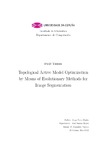Mostrar o rexistro simple do ítem
Topological active model optimization by means of evolutionary methods for image segmentation
| dc.contributor.advisor | Santos Reyes, José | |
| dc.contributor.advisor | González Penedo, Manuel Francisco | |
| dc.contributor.author | Novo Buján, Jorge | |
| dc.contributor.other | Universidade da Coruña. Departamento de Computación | es_ES |
| dc.date.accessioned | 2013-06-11T12:10:02Z | |
| dc.date.available | 2013-06-11T12:10:02Z | |
| dc.date.issued | 2012 | |
| dc.identifier.uri | http://hdl.handle.net/2183/10071 | |
| dc.description.abstract | [Abstract] Object localization and segmentation are tasks that have been growing in relevance in the last years. The automatic detection and extraction of possible objects of interest is a important step for a higher level reasoning, like the detection of tumors or other pathologies in medical imaging or the detection of the region of interest in fingerprints or faces for biometrics. There are many different ways of facing this problem in the literature, but in this Phd thesis we selected a particular deformable model called Topological Active Model. This model was especially designed for 2D and 3D image segmentation. It integrates features of region-based and boundary-based segmentation methods in order to perform a correct segmentation and, this way, fit the contours of the objects and model their inner topology. The main problem is the optimization of the structure to obtain the best possible segmentation. Previous works proposed a greedy local search method that presented different drawbacks, especially with noisy images, situation quite often in image segmentation. This Phd thesis proposes optimization approaches based on global search methods like evolutionary algorithms, with the aim of overcoming the main drawbacks of the previous local search method, especially with noisy images or rough contours. Moreover, hybrid approaches between the evolutionary methods and the greedy local search were developed to integrate the advantages of both approaches. Additionally, the hybrid combination allows the possibility of topological changes in the segmentation model, providing flexibility to the mesh to perform better adjustments in complex surfaces or also to detect several objects in the scene. The suitability and accuracy of the proposed model and segmentation methodologies were tested in both synthetic and real images with different levels of complexity. Finally, the proposed evolutionary approaches were applied to a specific task in a real domain: The localization and extraction of the optic disc in retinal images. | en |
| dc.language.iso | eng | es_ES |
| dc.rights | Reconocimiento-NoComercial-CompartirIgual 3.0 España | |
| dc.rights.uri | http://creativecommons.org/licenses/by-nc-sa/3.0/es/ | |
| dc.title | Topological active model optimization by means of evolutionary methods for image segmentation | es_ES |
| dc.type | info:eu-repo/semantics/doctoralThesis | es_ES |
| dc.rights.access | info:eu-repo/semantics/openAccess | es_ES |
Ficheiros no ítem
Este ítem aparece na(s) seguinte(s) colección(s)
-
Teses de doutoramento [2150]






